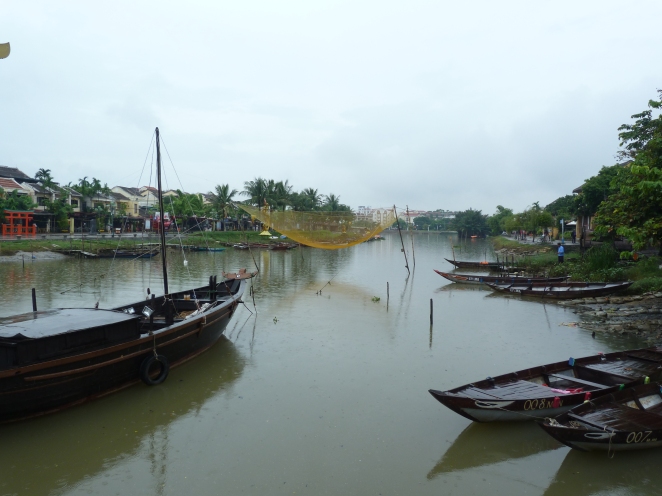
Hoi An is worth a stroll, but in the rain is considerably less fun
Hoi An
Hoi An, the ancient city bit is known for its resemblance to a French Village, preserving the colonial Indo-China style town as part of yet another UNESCO heritage site. It was highly recommended to us by many people, and it was definitely an interesting place. The main attraction is the river and the bridges with scenic riverfront buildings on either side of the water. Like other UNESCO heritage sites, the main thing to do here is try to fight other tourists to take a picture without the other tourists in it. Hoi An has been thoroughly touristed. Prices here are twice to four times as high as in Da Nang, so only get lunch here if you want to punish your wallet.
https://www.instagram.com/p/BaMBMgqAnsQ/?taken-by=we_quit_our_jobs_to_travel
You’ll pay more for everything in Hoi An, especially to get to the village. Take Uber, or as my local friend Hien suggests, take Grab, a cheaper motorbike option that will drop you at the village and allow you to arrange pickup at your convenience.
While being brutally ripped off for lunch, we overheard some women discussing their plans to stay in Hoi An for five days. Five days!!! It’s interesting and certainly worth taking a few pictures, splurging on a coffee and rambling a bit, but I would suggest limiting your time here to a morning or an afternoon. See a temple and wave goodbye as you motor on your way back to Da Nang.
Gosh Da Nangit!
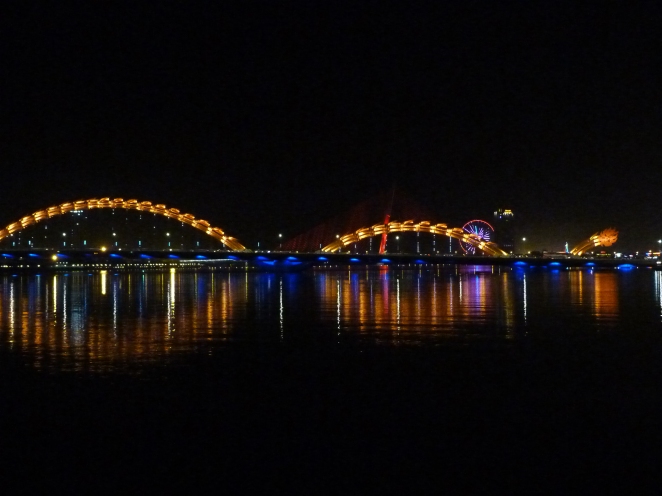
Da Nang at night is an impressive sight, full of dazzling colors and light
Ringing in as the impressive fourth largest city in Vietnam, Da Nang has a much different vibe than HCMC or Hanoi. It should be noted that there is also a dividing line that runs from a few blocks west of the beach through the middle of town, a line that is marked by average prices and tourists per square foot.
On the beach side, Da Nang has a row of resorts full of Russian, Chinese, French, German, and American tourists. With their private beaches and built-in restaurants, they mostly never venture past the line of towering hotels that make up the seaside. Hey man, that’s their loss! Venturing into the bustle of the larger city is well worth it for a food adventure or a run-of-the-mill anthropological experience. Da Nang is very much a large, everyday city full of normal people going to work and eating normal Vietnamese food. I’m sure there’s a formula that entails the price of food declining per meter as you head away from the water. We got dinner for 20,000 Vietnamese dong each at a little stall deep in the city, where you can find a big bowl of pho for less than $1. Granted, some of it is horrible, but there is a lot of really great food too. Overall, our experience was good, and for that price you have to be willing to risk a bellyache.
It’s a Day at the Beach!
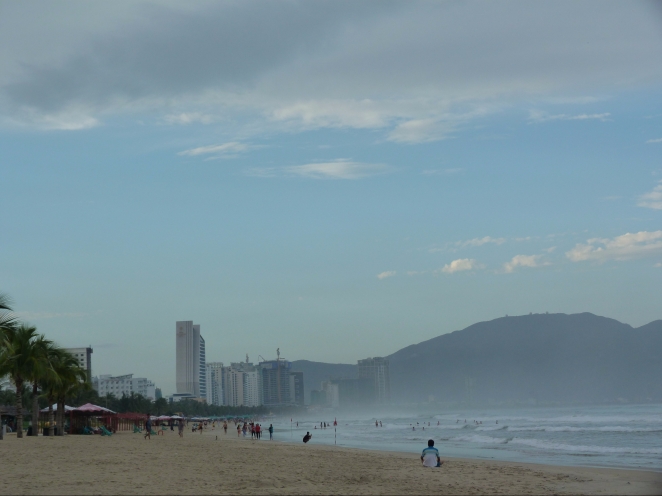
Da Nang’s coastline on a stormy day
After you’ve had your fill of the commotion in the city, and oggled the dazzling lights of Da Nang at night (which are seriously glitzing), please take a day off and go plant yourself in a beach cabana. Pick a day that it’s not raining, and ideally one not too close to typhoon weather and pay about $3 to rent a cabana for as long as you like. The beach in Da Nang runs the length of the city and abuts a couple marvelous mountains to the north. If you fancy a swim, make sure the waves aren’t too insane because the overzealous life guards won’t cut you any slack, and, in fact, we saw one kick a local man after he braved a dip in the roaring tide when he wasn’t supposed to. However, you’ll find an ample supply of refreshing drinks to sip waterside. Try a freshly cracked coconut or an iced Vietnamese coffee and enjoy zoning out a bit as the tide rolls in along the long, beautiful coast. Make friends with the bartenders and don’t sweat it when a gaggle of Chinese tourists want to take selfies with you, feel those beach vibes and smile.
On to the Delta…
Not to be alarmist, but if you want to see the Mekong Delta, you have limited time. The Chinese have been building dams for the past five years or so and are set to complete more soon at several points along the Mekong River, that begins at the Chinese-controlled origin of the river. You don’t have to know a lot about rivers to understand that the more the Chinese choke off the source, the less the river will flow. As the river dries it will destroy traditions, communities, and the way of life of people in Laos, Cambodia, Vietnam, and of course China. Not to make the Chinese Development Bank out to be a villian here, come on folks there’s no imperial country that isn’t guilty, but there was a theme on our trip, and I’m just saying, it was that everyone is nervous about China destroying their way of life.
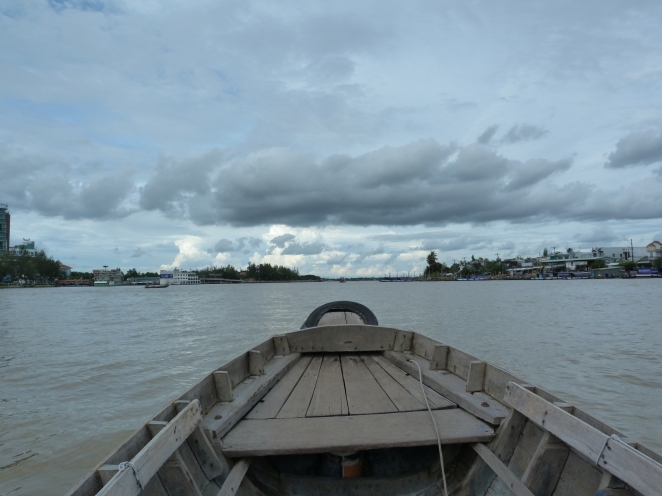
Taking a boat ride with an old lady in her miniscule boat is an authentic way to be terrified by the scale of the Mekong
Anyway, the Delta is in real danger from this, as well as from development of other kinds, i.e. roadways, techology, and even, yes, tourism! So, if you want to see it before it’s gone, counterintuitively, go and visit it before it’s too late. Don’t just take my word for it, please read this incredibly thorough and well-written (as always) article from The Economist. This is why I chose this year to visit the delta.

Wild jackfruit, pineapples, coconuts, black pepper, and a variety of other fruits and spices grow wild along the backwater paths
Be careful about how you get there, of course. There are tours that will whisk you down to the delta and back in a day and with the new highways that connect the growing cities there, it shouldn’t be too uncomfortable. But it will cost you at minimum $65 and a miserable visit to a pineapple farm and a coconut candy factory (with an obligatory purchase of 5kg of candy). Heeding the advice of those that came before and lived to tell the tale (on Tripadvisor) and also share an aversion to being ripped off, we decided to do it on our own). And our experience getting to Can Tho was interesting enough…

A picturesque scene of bamboo swallowing an untended harbor, at first I thought this boat was abandoned but realized many people were using boats in similar shape to transport themselves and goods around the delta
A ticket from the Ho Chi Minh City airport to the bug bus station is around $2. From there, there are a multitude of companies that offer cheap yet comfortable service to Can Tho, Ben Tre and other locations along the Mekong. Of course, knowing so little, we didn’t choose one of those services. We walked up to a window and said “Kann Toe!” to which the ticket seller looked confused, then seemed to understand we meant Can Tho. A woman ran over to us and hurriedly grabbed us, “Can Tho? Can Tho?” She asked, and dramatically added, “Must hurry!” So we paid around $5 each or 110K Dong. And we did not enjoy that ride, let me tell you! The bus, like many of the long haul buses in Vietnam, have semi-reclining seats, much like the seats in a dentist’s office, except these didn’t smell extremely sterile (and, in fact, were not extremely sterile but quite the opposite)… Also, Sophie discovered about ten minutes into the journey that she had a seat companion, a large roach named Pho, living in the pocket where riders are expected to stick their odiferous feet. In addition, a really poorly-executed Vietnamese drama about a singing pageant winner with family drama was blaring on the television for 90% of the journey. Added to that cacophony was the screeching laughter of the ancient woman perched in the seat in front of me, who turned around to glare at me every fifteen seconds and moments later smacked my feet with mirth when the show’s protaganist delivered each cheesy punchline. In short, it was not a fun trip down.
Can Tho, you should go!
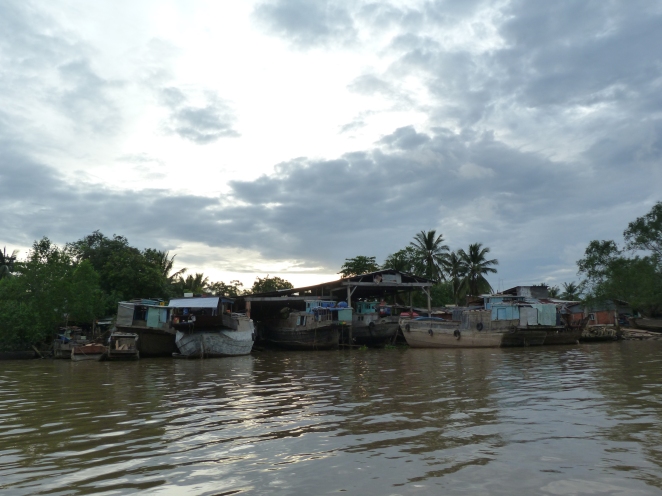
The dwellings and palms along the river and its small tributaries is beautiful around sunset
However, Can Tho is worth the arduous journey. Having grown at such a rapid clip, the population skyrocketing in the past five years by about ten times, it is surprisingly now a bustling city. With the construction of the new highway, the city is also choking the boating way of life of the people that used to ship and sell on their little skiffs. As Doi, our gregarious and well-informed tour guide explained, the floating market at Cai Rang, once a truly gigantic affair consisting of 1,000+ boats, has since shrunken to a meager 150 or so merchants peddling pineapples, mostly for the benefit of tourists. The reason, Doi elaborated, is that it is much easier and more cost effective to ship by truck on the new highway. His dire prediction, though tinged with his infecting optimism, is that the market will cease to exist within three years or so. Life is changing on the delta.
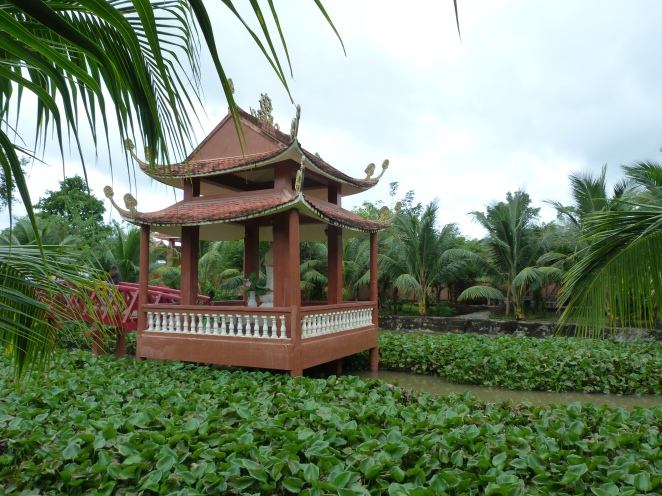
A pagoda deep in the delta
But, we had a chance to enjoy it while it’s still there. We bargained with a decrepit old woman, who was so bow-legged she waddled like a turtle, as she offered us the best sunset cruise in Can Tho on her boat. We agreed, and when we returned at dusk, she said, “Yes, go with my sister.” I doubt it was her sister, but another equally hunched woman puttered us around the delta, and even enjoyed making me row the boat for a while, across the Mekong at a wide point, cackling at my difficulty in operating the standing oars. By the time I got the hang of it, she had lost interest, and we zoomed along backwaters through dense jungle, past humble waterfront houses, and abandoned, half-sunken boats.
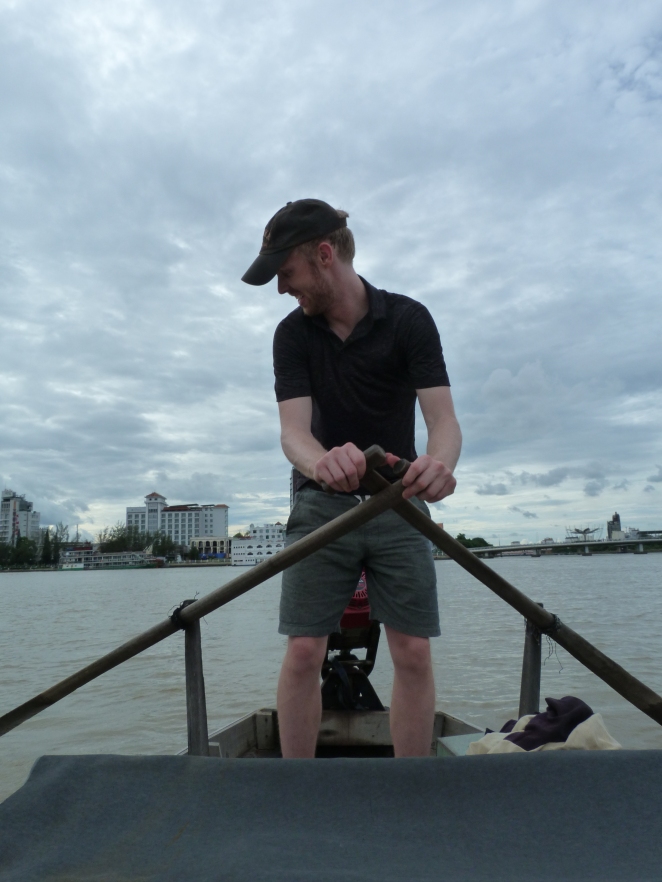
Rowing one of the “traditional” boats was surprisingly complicated and required more coordination than I possess
We wanted to see ‘the real delta’, but we were skeptical of tours, however, after carefully perusing the tours on offer at our hotel, we took the plunge. We got lucky. Our tour guide, Doi, training at a local school for tour guides, was a delightful person to enjoy the sights, sounds, and smells of the delta. We went for a muddy bike ride to a shrine, deep in the jungle, sampling wild fruits and leaves along the way, as we happened on them. We visited a somewhat tacky rice noodle factory and say a brand new monastary that the jungle had already half eaten. We took a boat ride, exploring an entirely new bit of the backwaters than we had seen at sunset. Finally, Doi took us for a meal at a local place, warning me, “it’s not included in the tour’. It was OK, it only cost us about a dollar for a soda and bao xio, meat or veg wrapped in local leaves, i.e. banana, mint, basil or a variety of tree leaves that are consumed locally. Dipped in a local, but unknown sauce that really made the whole leafy wrap palatable, it was one of the more memorable meals for the atmosphere. “I want to take people to local places, show them the real Can Tho”, Doi explained, beckoning to the long concrete, warehouse-building full of cafeteria fold-up tables with plastic chairs. It was truly local and incredibly delicious. Before departing, Doi recommended we try Vietnamese hotpot on the street in Can Tho called ‘hot pot alley’.
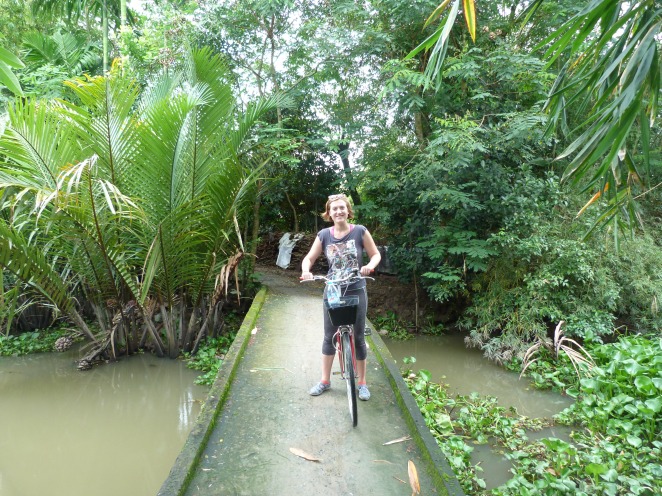
We biked around the backwaters of Can Tho, seeing a good amount of the muddy countryside
So, that night we stumbled, fatigued from biking around the narrow, muddy paths of the delta through bamboo forests and rice paddies, onto a street humming with motorcycles and Vietnamese youths. Nothing was in English on any of the signs, so we knew we were on the right track. We passed over a few places after a dirty look or two, and finally decided on the last choice, a place that looked like a cross between a parking garage and a lawn party. A young guy saw us looking at the menu and smiled, giving me the thumbs up, then he stuffed a chicken liver in his mouth and gave me another thumbs up and a nod.

A local shrine to the sacred, now-extinct wild tiger that roamed in the region before migratory resettlement of the delta region around a thousand years ago. People still burn incense and ask the tiger to protect their family from illness and harm.
“Ok,” I said, “This is the place for us”. We sat down and pointed at a few things on the menu, the adolescent waiter lit up a huge burner and dropped on a gigantic pot of clear liquid, and brought about fifteen little bowls which contained all manner of meats, vegetables, spices, noodles, fats, and other unknowns. We shrugged, and started chucking things in, a dash of red fiery sauce, a handful of offal, a cube of fat, a splash of that dark black broth. Then, we waited, basking in the ambience of the laughter of local people enjoying a meal with friends. There was a lot of anticipation. After it was thoroughly cooked, we pulled out some pieces, added the noodles, and chowed down. It was very good, and just the right amount of spice that we cried a little. As we were leaving, the guy threw us another thumbs up, this time an inquisitive one, like “Was it good?” I nodded to signal yes, it was very good.

Sophie looking a bit dazed and perhaps underwhelmed at Cai Rang after getting up at 4am to see a lot of pineapples on boats
I want to mention one more awesome place in Can Tho. A&T Coffee. For 15K dong you can get an excellent pate bahn mi and for 20K more, you can add on a great little coffee that is sugary as candy but also bold and robust. It doubles as a pawn shop, and if you’re not careful the owners will politely ask you to play the guitar and sing for them. After I asked if I could noodle on the guitar a bit, the owner asked me to play a song. “Ok,” I said shyly (this was our second visit) and I played House of the Rising Sun. “You come back later?” she asked. “Maybe,” I said. A lot of the places we went on our trip, we ended up going back a second time if we were sure we wouldn’t get food poisoning or ripped off, but Sophie and I drew the line at three times, that was just getting weird.
Last bus out of Saigon
So, we had learned to be more careful when getting bus tickets in Vietnam. We had our hotel book our tickets on the way back to HCMC, and what a difference! For the same price, FUTA picked us up, gave us a bottle of water, and the bus was sparkly clean. So, word of caution, do your research so you don’t end up with Pho the roachy seat mate.

Enjoying views of the palms and water plants along the might Mekong
So, we didn’t get to see as much of the delta as we would have liked, in reality, it is still hard to get between places. But we loved Can Tho, and the people were a world away from the attitude in HCMC. As we ventured south in Vietnam, the people got friendlier and friendlier, and Can Tho was the icing on the coconut. Every adorable little kid we biked by in the Delta and every shop owner was eager to wave and say hi, ask where we were from, how we liked the Delta. The proprietor of our hotel went out of his way to make us feel comfortable and went beyond making us feel like customers, and instead made us feel like guests. I’ve never seen deeper smile lines or the look of contentment of the fishermen who lazily threw out their nets into the muddy depths of the Mekong. The hospitality made me think of the lyrics from Proud Mary,
“they don’t have no worries,
they ain’t got no money,
people on the river are happy to give.”
I hate to think that that culture will change as Can Tho grows exponentionally. As Doi explained, construction and migration are the new way of life in Can Tho, there’s not enough housing and an influx of people, investments, and tourism will completely alter the way of life. But that’s the way of rivers, as my favorite Disney princess says, “You never step in the same river twice”.
-Brian
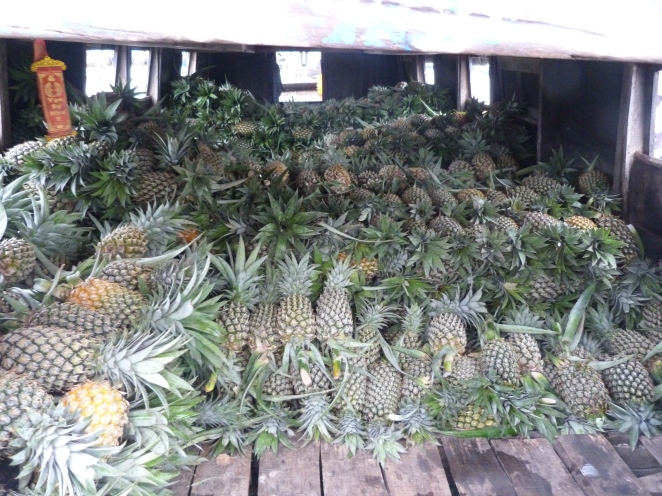
A woman reluctantly sold us one pineapple after hauling them all the way from Cambodia on the river, hoping to sell them in bulk on a slow market day
